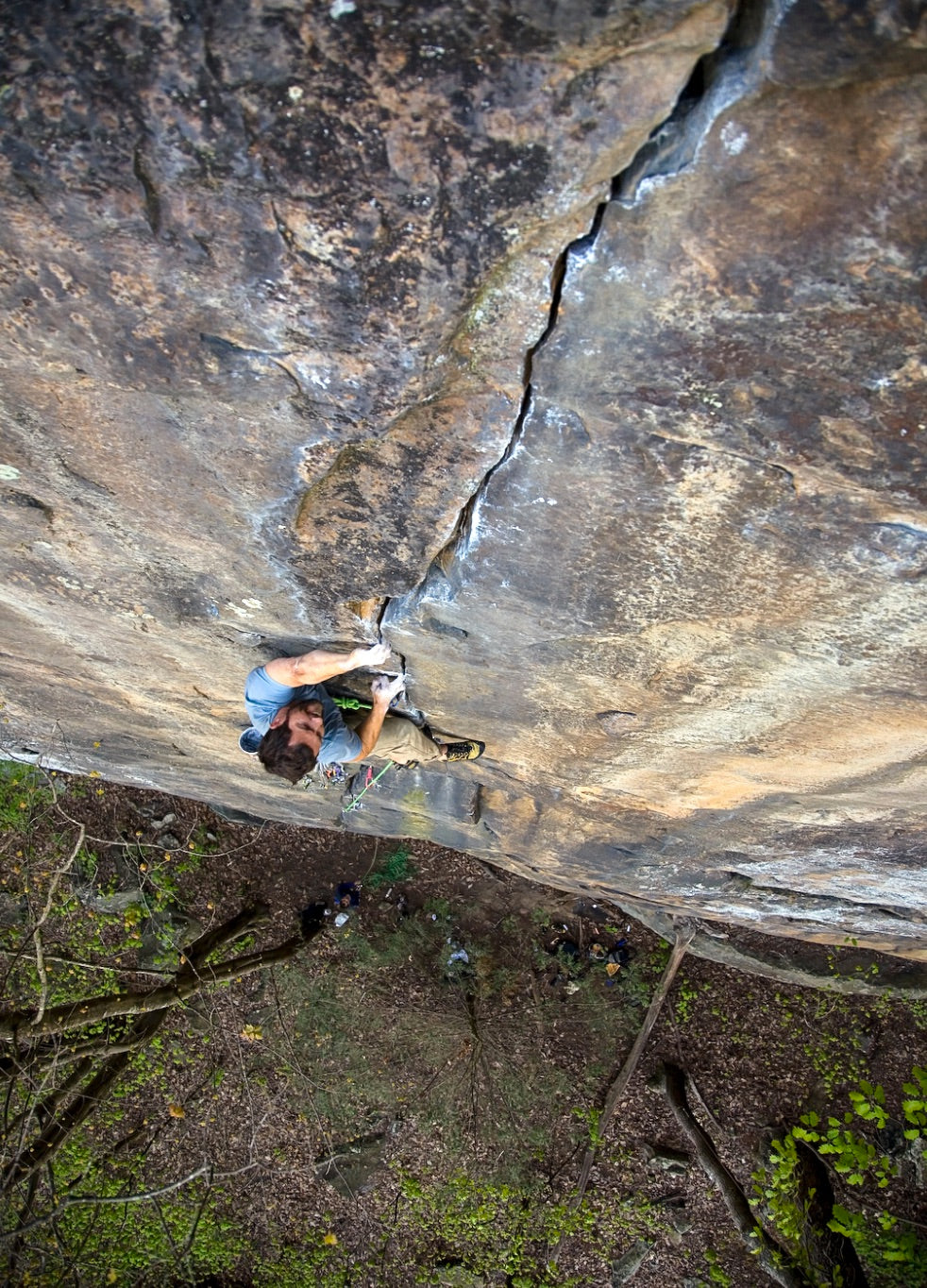By Paul Nelson
“I got lost trying to find it.”
“We wound up having to do the climb-out in the dark.”
“South Nuttall? More like South NETTLE!”
“The only warm-ups are 5.10 offwidths that don’t have anchors.”
“That poison ivy vine is thicker than a tree trunk!”
“It’s like Beauty Mountain’s evil twin– shady, with a goatee, and bent on world domination.”
This is a story of the best trad crag at the New River Gorge: South Nuttall. If you’ve climbed at the NRG much, you’ve likely heard of it, usually in hushed, awed tones as someone repeats one of the above phrases. But despite the aura of mystery and inaccessibility that surrounds “Snut,” it’s not a secret crag (we’ve got those too at the NRG). It’s laid out clearly in the guidebook, and you can see it from other viewpoints atop our beautiful river gorge; it’s simply the farthest upstream section of good rock on river-left. Straightforward and obvious, right?

Looking upstream from the South Nuttall cliffline (photo by author).
Well, maybe not so much. At the New River Gorge, where visiting climbers are spoiled by easy, sub-30 minute approaches and trails maintained by a solid partnership between the Park Service and the New River Alliance of Climbers (NRAC), the Snut approach takes a bit more effort. Instead of obvious trails and junctions, you’ll get vague directions from locals like “walk with the clifftop to your left, keep an eye out for NPS boundary plaques, and then descend the gully where there’s a rock wedged in a tree branch.” The crag’s upstream access point was recently closed off by a private landowner, and downstream access involves some backwoods orienteering to unobvious rap-in points.
Once you’ve found your way to the base of the cliff, the difficulties continue. Cliff-base trails come and go; and there are thick patches of poison ivy and stinging nettle that you simply have to tromp through. Many climbs will have healthy layers of silt and spider webs all over them. If you get on the sport routes, expect to see bolts that were placed in the 1990s and have rusted considerably. The easiest trad climbs are old-school 5.9+, and many lack top anchors. When the day is done, the only exits are a couple of downstream climb-outs that are just barely easy enough to do ropeless, but still terrifying at the end of the day (last time I did one of these climb-outs, a rogue rhododendron branch snagged my backpack and almost pulled me backwards off the 60 foot cliff). It takes a bit of effort to climb here.

Matt Carpenter attentively spots/belays Louis Aden on the “5.9” squeeze chimney, Inchworm.
So what is the allure of this place? Solitude and adventure, obviously; shade for the hotter months; huge, soft patches of untrammeled moss that seem straight out of Lord of the Rings due to low traffic. Oh yeah, and the best line-up of hard crack lines between Indian Creek and the Spider’s Web.
Many climbers who make the multi-trip pilgrimage to Snut do so to work their way through a myriad of 5.12 cracks. Although these splitters are pretty “pure,” they’re not brainless Indian Creek plug’n’chug affairs. Like many NRG lines, expect to have a few face cruxes thrown at you in between pumpy jams.
The first tick on many lists is The Beckoning, a 5.12a situated at the far upstream end of the crag. As you struggle through the frustratingly non-straightforward and technical low crux in a shallow stemming dihedral, remember that this was put up in proper traditional onsight style back in the 1980s.
Once they’ve sent The Beckoning, most climbers move onto Fingercrack in a White Corner (5.12a), a beautiful line set back in an amphitheater, flanked by hard sport routes on one side, and a 80 foot high mass of poison ivy on the other. Although there are plenty of jams and laybacks on this route, it’s got a bit of that typical New River Gorge devious face-climbing too, making it a tough onsight.
When you’ve put away the easy 12’s, your horizon opens up to even more laser-cut, pure jamming lines. The New Traditionalists, first led by Eric Hörst, is easily one of the best cracks in the nation. There’s a bit of everything on this line– chimneys, fingercracks, conveniently-spaced handjam rests– but the crux involves a crescendo of sequential tips locks building to a desperate stab at a bottoming out ringlock.

John Averrett jamming towards the crux of New Traditionalists (Photo by Pat Goodman).
As you lower off of New Traditionalists you’ll likely be thinking, “this is the purest splitter at the New!” You may want to hold that judgement until you hike another ten minutes downstream and gaze upward at the burly Luv Nuthing (5.12c). Although its base is unfortunately guarded by some chossy wideness and a huge rest hueco, the 30 degree overhung, right-leaning splitter above is truly jamming paradise, going from hands down to tips.

Matt Carpenter in the midst of Luv Nuthing (photo by Jeff Achey/Wolverine Publishing).
Luv Nuthing was established by the late Brian McCray, who spent the late 1990s at the New River Gorge, putting up an insane amount of hard sport and trad lines. Most well-known for his F.A. of the popular 5.14a Proper Soul across the river at the Cirque, McCray also plucked many of the unclimbed and hardest cracks at South Nuttall, too.
In my opinion, his crowning achievement (and Snut’s King Line) is Temporary Insanity (5.13). This striking splitter is stacked with 5.12 crack climbing, as well as three distinct cruxes where the crack disappears and forces the climber to execute pumpy boulder problems on pinches, underclings, and crimps. Temporary Insanity went unrepeated for nearly two decades until Pat Goodman snagged the second ascent a few years ago. More recently, in the fall of 2017, visiting European climbers James Pearson and Caroline Ciavaldini made quick repeats of the line. Impressively, Pearson went for the true onsight, ignorant crucial face beta at the bottom of the splitter,and simply climbed the crack straight in, likely upping the grade into the 13+ range.

Pat Goodman looking up towards the second ascent of Temporary Insanity (photo courtesy of Pat Goodman collection).
This is only a tiny sample of the awesomeness that is South Nuttall, but there is much more: unsent 5.14 sport projects in need of rebolting, massive multipitch tiered roofs emerging out of 90 foot deep caves, facey headpoint lines, and enough 5.10s to make it worth the trip for moderate climbers.

Brooks Wenz on Guillotine, an excellent 5.10+ corner. Appropriately, several years ago a climber pulled off the shield-sized namesake flake of this climb, which was located just to the left of the climber; you can still see it impaled in the ground at the base of the route (photo by Pat Goodman).
Last year as some friends and I were hiking in to the crag, we came to the struggling realization that, even though isolation and solitude are cool, it would be great to get just a few more climbers out to Snut to clean up some routes, establish responsible trails, and that sort of thing. Due to its lack of moderates, the crag will never become another Bubba City-style zoo-crag, and more responsible climber traffic could lead to bolt replacement and a few more sustainable top anchors. Like I said above, this is not a “locals only” crag; we want to share its awesomeness!

Snut is not just cracks. Louis Aden checks out the beautifully sandbagged final headwall of Brian McCray’s Heaven Cent. Big reaches between small holds define this 5.13a. (Photo by Pat Goodman)
At the same time, I don’t intend this article to be a hand-holding guide to the crag. There’s no detailed approach beta online for the mountainproject masses, and I think it should stay this way. If you want to check out Snut, get a copy of the current guidebook, pour over Google Earth and some topo maps of the area, and then set aside a day to scout out some approaches and rappels. Once you have your approach dialed in, it’s not a much bigger deal than hiking to the more remote sections of Endless Wall or the Meadow River.
Better yet, hit up a local and/or ask about Snut at Water Stone Outdoors. We’ll be happy to direct your next adventure over the ridges and through the forest thickets, from the rhodos to the poison ivy, all the way to the base of the New River Gorge’s raddest, traddest crag.
ABOUT THE AUTHOR:
Misty Mountain athlete Paul Nelson has climbed at the New River Gorge for over a decade, and has lived there full time since 2013. Because he is not a photographer, he thanks Jeff Achey and Pat Goodman for graciously donating images from their collections for this piece.

